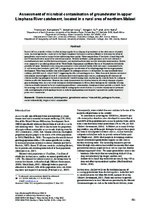| dc.contributor.author | Kanyerere, Thokozani | |
| dc.contributor.author | Levy, Jonathan | |
| dc.contributor.author | Xu, Yongxin | |
| dc.contributor.author | Saka, John | |
| dc.date.accessioned | 2013-09-11T12:52:41Z | |
| dc.date.available | 2013-09-11T12:52:41Z | |
| dc.date.issued | 2012 | |
| dc.identifier.citation | Kanyerere, T., et al. (2012). Assessment of microbial contamination of groundwater in upper Limphasa River catchment, located in a rural area of northern Malawi. Water SA, 34(4): 586-596 | en_US |
| dc.identifier.issn | 0378-4738 | |
| dc.identifier.uri | http://hdl.handle.net/10566/710 | |
| dc.description.abstract | In rural Africa, scientific evidence is often lacking to guide the scaling-up of groundwater as the safest source of potable water. An investigation was conducted in the Upper Limphasa Catchment in northern Malawi to determine the safety of groundwater sources and to explore factors influencing water quality. Water samples from 17 boreholes, 6 hand-dug wells and 90 households were analysed for selected parameters. Portable incubators, multi-parameter probe and colorimetric standard methods were used for field measurements, and standard methods were used for laboratory water analysis. Results were compared to specified guidelines of the World Health Organization and Malawi Bureau of Standards to establish the potability of water. Statistical results using non-parametric t-tests indicated that the wells were more contaminated with E. coli bacteria than boreholes (p=6.2x10-6), suggesting non-consideration of local hydrogeologic factors in groundwater development. Water from boreholes that tested negative for pathogens at source tested positive at some households (total coliform: p=0.0042 and E. coli p=7.8x10-7) suggesting the effect of handling practices. Water from wells that was not treated with chlorine showed higher levels of E. coli than treated water from the same sources, confirming the effectiveness of chlorine in reducing pathogenic bacteria in households’ stored drinking-water, reinforcing the scientific basis for scaling up chlorine as effective disinfectant. However, this study demonstrated that chlorine failed to effectively eliminate all pathogens in drinking water. As a case study in tropical rural environments in Africa, these findings on the suitability of using chlorine as disinfectant and on factors explaining groundwater contamination, though provisional, provide a scientific basis for assessing cost-effectiveness and sustainability of scaling-up the use of chlorine as a curative remedy and of systematically investigating local hydrogeologic factors in order to implement measures to protect groundwater quality in poverty-prone rural communities. | en_US |
| dc.language.iso | en | en_US |
| dc.publisher | Water Research Commission | en_US |
| dc.rights | © 2012 Water Research Commission. This file may be freely used provided that the source is acknowledged. No commercial distribution of this text is permitted. | |
| dc.source.uri | http://dx.doi.org/10.4314/wsa.v38i4.14 | |
| dc.subject | Chlorine treatment | en_US |
| dc.subject | Drinking water | en_US |
| dc.subject | Groundwater sources’ vulnerability | en_US |
| dc.subject | Pathogenic bacteria | en_US |
| dc.subject | Social vulnerability | en_US |
| dc.subject | Tropical rural communities | en_US |
| dc.title | Assessment of microbial contamination of groundwater in upper Limphasa River catchment, located in a rural area of northern Malawi | en_US |
| dc.type | Article | en_US |
| dc.privacy.showsubmitter | false | |
| dc.status.ispeerreviewed | true | |
| dc.description.accreditation | Web of Science | en_US |

